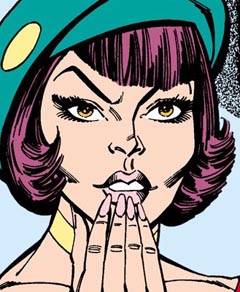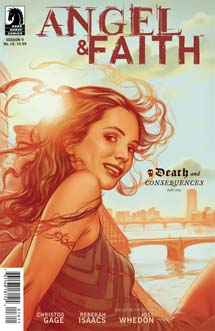There are no spinoff TV series, movies or books, but almost nine years after “Angel” aired its final episode, the Buffyverse is thriving in comics. In fact, there are currently four titles going under the Season 9 banner: The regular titles “Buffy” and “Angel & Faith,” plus the miniseries “Spike: A Dark Place” and “Willow: Wonderland.”
A little more than a year into Season 9 (we’re at about the halfway point, Dark Horse tells us), the franchise has stepped it up from Season 8, although some of that season’s muddled story remains hard to shake off. This is the lone flaw of the best title going, “Angel & Faith,” where the characters’ history of helping each other through their alternating dark periods is coming back to bite Faith, as — by siding with Angel after his bad decisions of last season — she’s made enemies with some Slayers who used to look up to her.
It’s been cool to see characters such as Drusilla, Whistler and Giles again, along with fitting twists for each of them: Drusilla briefly being sane, Whistler working both sides of the cosmic game, and Giles seemingly resurrecting himself from the dead. The latter two points are where the muddled-ness comes in: What’s the point of Whistler working for both the good guys and the bad guys? He claims “balance” is important, but wouldn’t it be better to have good prevail over evil? And how is Giles alive when Angel so clearly killed him last season? I’m guessing the answer lies with the “supernatural death” exception we learned about when Willow resurrects Buffy in Season 6 (Still, since Angel snaps his neck a la Jenny Calendar, further explanation is needed). At any rate, it’s great that we’re going to get more stories about Giles, who has been nicely kept in the forefront thanks to flashbacks.
“Buffy” has also been twisty and turny this season, most notably when Buffy learns she is pregnant, and later when she is shocked to find out she’s a robot. Some readers accused the baby/abortion plot of being undermined by the robot twist, but I didn’t mind too much. Although mostly set in modern times (plus the supernatural element), “Buffy” has snuck in some decidedly futuristic science throughout its run, starting with “Ted” in Season 2 and continuing through Warren’s creation of April and the Buffy-bot in Season 5. Andrew being able to transfer Buffy’s brain into a robot and back again really pushes the envelope; thank goodness Andrew is a good guy, because he’d be unstoppable if he used his mad genius for evil.
Recently, “Buffy” has irked some fans with issues focused on side characters like Kennedy (whom it seems nobody likes) and the new introduction Billy, a put-upon gay kid who assigns himself to Slayer duties in his town, something a lot of people are doing amidst the zompire infestation. Because the “Billy the Vampire Slayer” arc was penned by TV show writers Jane Espenson and Drew Z. Greenberg, I forgive the series — barely — for going two-straight issues with hardly any main characters.

Spike is the character that translates best to comics, thanks to the outsized performance by James Marsters and writer Victor Gischler’s feel for capturing Spike’s voice — even the fact that he’s hanging out with alien bugs (holdovers from the IDW yarns about Spike and Angel) isn’t as annoyingly comic-booky as it should be. He’s going through his latest “overcoming temptation and proving his goodness” arc in the “Spike” miniseries, as he rejects the overtures of a sassy succubus by the name of Morgan. The latter is searching for magic shards that will help her open a Hellmouth — part of the fallout from Season 8 is that magic no longer exists, and therefore the residual magic items on Earth have become extra valuable. (This miniseries is moving Spike from “Buffy” to “Angel & Faith,” further assuring maximum readership for all titles. Not that any true fan would be picking and choosing anyway.)
The “no more magic” fallout sort of ties in with “Willow: Wonderland,” where the title character is going through a weird spiritual journey in another dimension that has echoes of “Alice in Wonderland.” So far, this is the weakest of the four current titles, in part because the story isn’t particular meaty, nor does it work as a character study as well as “Spike” does. I don’t dislike Willow, but I haven’t really connected with her from about Season 5 forward. Also, the artwork is more stylized here, whereas the likenesses are spot-on in the other three titles, something that helps me imagine I’m watching a TV episode.
Season 9 in comics isn’t as good as it would be on TV, but it’s as close as it gets without the actors stepping into those roles again. And every time I pick up an issue, I’m thankful Joss Whedon has seen fit to keep the story going.

